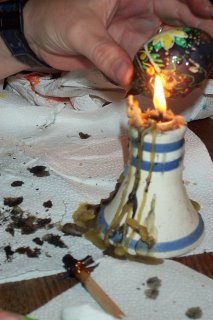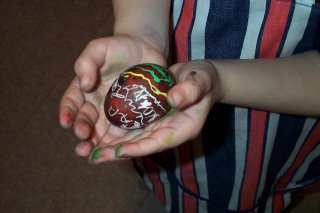My entryway into the Bible was Good News Club—a lovely grandmotherly lady down the street offered Bible stories (with cutout paper figures placed on a flannel board, the technology of the mid-sixties), followed by chocolate cupcakes. During winter months, children would arrive at her sunporch, to find a fire crackling in the fireplace, and those cupcakes waiting in the kitchen. She would read the text from the King James and move paper figures around the board, and we would sing Bible songs. Somehow I learned those stories well enough that I remembered basic plotlines and characters a decade later, in college Bible courses. Of course I also remembered the characters as clean, pale-skinned and well-shaven, but that’s another story.
A few years back, remembering my affection for those stories, I found a tastefully-done video of Old Testament stories to watch with my children. I started with Joseph and His Brothers, but my poor Madeleine wailed “Turn it off!” just when the brothers began to toss Joseph in a pit. “How can people be so mean, Mama?” I was wishing for those chocolate cupcakes to distract her. And I had to agree with her. I decided not to tell her that the world can be very mean, sometimes. She will learn that soon enough—but not yet. Montessori education says, “follow the child,” to see what she can handle, and I see that my children may be more delicate than most.
So what is the developmentally appropriate time to introduce delicate kids to the story of the cross? I haven’t spent a lot of time wondering—I simply put off making a decision.
Each Lenten season, my favorite Montessori-trained teacher Jane leads extraordinary art workshops: children produce The Stations of the Cross over the course of six weeks, then they lead congregants through that worship service during Holy Week. Each year Jane chooses a different medium. Like my childhood Good News Club, there are great snacks and great times together. But the Stations of the Cross? That’s walking step by step through the worst that humanity has to offer. That’s the mean old world, at it’s meanest.
Last year Madeleine was old enough, but I kept her back—if she thought Joseph’s brothers’ meanness would drive her to tears, what would she do with the story of the cross?
This year, Brendan turned six, and he caught wind of Jane’s Lenten art project, and was immediately determined he and Madeleine should “do the Art.” Is a parent going to say “no” to that? I spoke with Jane about their readiness, my hesitance. They studied in church school how the Good Shepherd lays down his life for his sheep. They studied how the grain of wheat must die to bring new life. She had prepared them, she said. Of course, we say each week in the liturgy,
Christ has died, Christ is risen, Christ will come again. They know about the cross—they just don’t know in any harrowing, bloody detail. I trust Jane, so I took a deep breath and I dropped them off the first week to sketch out their collages.
Brendan arrived home very excited. “What does ‘scourge’ mean again? What does ‘mock’ mean? What does a spear look like?”
I tipped my head skyward to blink back tears, and I answered his questions with definitions and sketches. “Did Jane read through the whole story, Brendan?”
“Yes. I am making a collage of that word, scourge.”
“Tell me what else happens in the story. How does it end?”
“Jesus gets dead. People are mean and hurt him. Then he gets alive again and no one knows how.” He pauses, but only for a moment. “What’s a spear made of?”
I whisper a prayer of praise for Jane, the blessed teacher. He crossed a threshold. It is time. Madeleine chooses Jesus entering the gates of Jerusalem for her collage, complete with palms, and chooses also to portray Simon of Cyrene lifting Jesus’ cross in a second collage. She has crossed a threshold, too.
Perhaps twenty people arrived for the Stations of the Cross, and each was greeted by Brendan, who proudly hand-delivered a church bulletin. A six-year-old boy who cannot read, he solemnly stood by each station as a candle was lit, and listened to the other children read verses from the Bible. He fidgeted a little, got a little distracted as older people meditated more slowly than he would like, but he stayed remarkably serious. Madeleine firmly planted her feet and read clearly, and talked with people ten times her age about how she developed her design.
Though he is two years younger than any of the other your artists, somehow Brendan’s portrayal of the scourging of Jesus is the most moving. The background is a collage of stone walls (cut from National Geographics). And in the foreground, left of center, two red-cloaked figures raise flashing silver swords and sticks over a third red-cloaked figure, arms slightly raised. There are no faces, and the only details are the swords, which are Brendan’s interpretation of spears and bludgeons, no doubt. That’s what scourge means, though. He may not understand the story enough to cry, like me, and I cry nearly every time I read through this story-- but he understands it.
Was it just last year that I lamented Easter translated to bunnies and eggs, for my children?
(http://dvivid.blogspot.com/2006/02/ashes-and-glitter-glue-2005-rumination.html )Each year I hold this tension, between one culturally-embraced Easter story and the central, life-altering Easter story. Unlike the years before parenting, I cannot claim any purity of lifestyle in the Easter holiday department. This year I crafted and sold bunnies and eggs for my store—not because I like their connection to the Easter holiday, but because I have a knack for beauty, and I confess to a weakness in the area of well-crafted cute things. My children and I decorated eggs, too, with Ukrainian tools and dyes, talking about the love of good work as we spent hours with the wax and candles. They laughed when I told them the lovely prophecy about the end of time, when the cowbells and pots and pans will be inscribed Holy to the Lord. “And even the eggs, too!” says Brendan, so diligently etching and dipping his egg in the dye.
There’s a lot to be said for beauty, for the turning of the seasons, for new life in blossoms and in chicks. But at last my somewhat delicate children and I begin this conversation about the true story of Easter, of Jesus’ death and resurrection, and life in this mean old world, which is not often sweet and certainly not often cute, or new like grass. Sometime I will tell them that we ourselves are sometimes “the mean old world,” when they are older and can understand a bit more. It’s going to be a long conversation, inbetween lots of silliness and kid stuff—they
are six and eight years old, after all. I get the feeling we will etch a lot of eggs and eat a lot of chocolate cupcakes in the meantime, but I’m waiting for the story to unfurl a little further, when they are ready, and when I am, too.
 This is Brendan's collage to represent Jesus' "scourged and mocked," for the Stations of the Cross at our church. See the story below, Mean Old World.
This is Brendan's collage to represent Jesus' "scourged and mocked," for the Stations of the Cross at our church. See the story below, Mean Old World. 

 Okay, last glimpse, though we will continue to "pysanky" after dinner each night, for this week, anyway. Madeleine wrote her teacher's name on one, with great love-- it fell to the floor with a cracking noise, but the front was unmarred. "It will stand up, now!" I said, and she tried it, and it worked. The multicolored ones are from the "bleeding tissue paper."
Okay, last glimpse, though we will continue to "pysanky" after dinner each night, for this week, anyway. Madeleine wrote her teacher's name on one, with great love-- it fell to the floor with a cracking noise, but the front was unmarred. "It will stand up, now!" I said, and she tried it, and it worked. The multicolored ones are from the "bleeding tissue paper."



